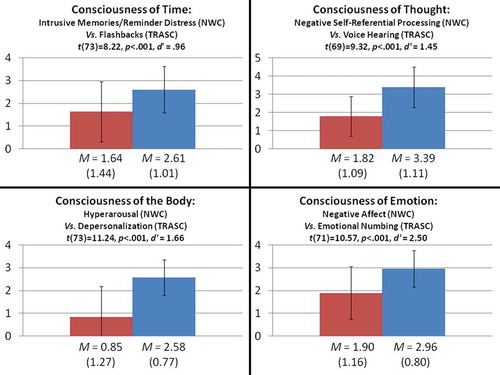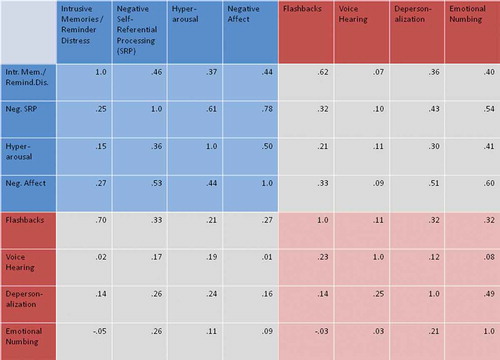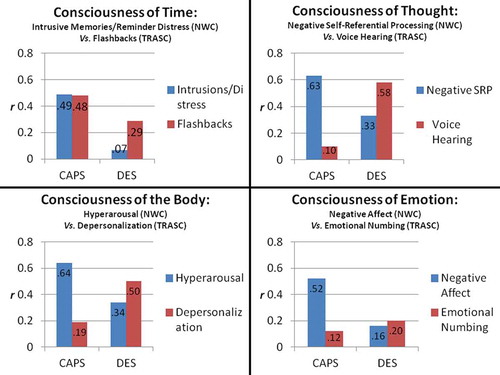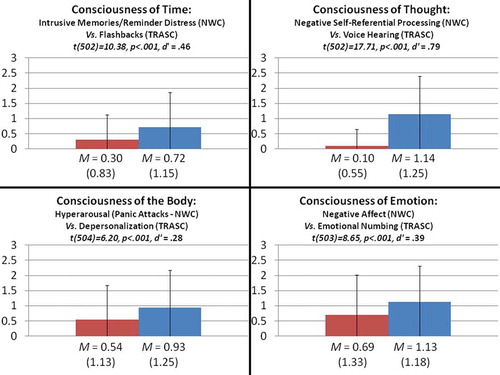Figures & data
FIGURE 1 The 4D-model of the traumatized self. Notes. Posttraumatic symptom dimensions of the consciousness of time, thought, body, and emotion are differentiated in so far as they present in trauma-related altered states of consciousness (TRASC) form (red, top) versus in normal waking conscious (NWC) form (blue, bottom). The background coloring of the two states, however, is illustrated as blending into one another in order to represent that it is presently not known whether the difference between the TRASC and NWC forms is a qualitative (categorical) or only quantitative (dimensional) one. The arrow that is increasing in infrequency from bottom (NWC) to top (TRASC) represents the first hypothesis that symptom endorsements of TRASC are expected to be less frequent than symptom endorsements of NWC distress. The arcs connecting the four dimensions are drawn with greater weight when referring to NWC distress versus TRASC in order to represent the second hypothesis that the experience of forms of NWC will be more intercorrelated when compared with the experience of forms of TRASC. The arrow labeled “dissociative” that is increasing from bottom (NWC) to top (TRASC) is intended to illustrate the third hypothesis that the four dimensions in TRASC form, while being distinct in concept from the measurement of dissociation as a disintegration and/or compartmentalization of psychological functions (e.g., Holmes et al., Citation2005; Steele et al., Citation2009), will nevertheless be more often observed in people who also experience dissociative disintegration and/or compartmentalization of psychological functions. Finally, the arrow labeled “Developmental TE [Trauma Exposure],” oriented in the same direction, is intended to illustrate the hypothesis that the etiology of TRASC may often be developmental in origin, that is to say, typically requires repeated trauma exposure at an early age of onset, when a child’s brain is naturally more vulnerable to deviations from NWC such as is normally exhibited through age-appropriate imaginary play.©W. W. Norton and Company. Reproduced with the permission of W. W. Norton and Company. Permission to reuse must be obtained from the rightsholder.
![FIGURE 1 The 4D-model of the traumatized self. Notes. Posttraumatic symptom dimensions of the consciousness of time, thought, body, and emotion are differentiated in so far as they present in trauma-related altered states of consciousness (TRASC) form (red, top) versus in normal waking conscious (NWC) form (blue, bottom). The background coloring of the two states, however, is illustrated as blending into one another in order to represent that it is presently not known whether the difference between the TRASC and NWC forms is a qualitative (categorical) or only quantitative (dimensional) one. The arrow that is increasing in infrequency from bottom (NWC) to top (TRASC) represents the first hypothesis that symptom endorsements of TRASC are expected to be less frequent than symptom endorsements of NWC distress. The arcs connecting the four dimensions are drawn with greater weight when referring to NWC distress versus TRASC in order to represent the second hypothesis that the experience of forms of NWC will be more intercorrelated when compared with the experience of forms of TRASC. The arrow labeled “dissociative” that is increasing from bottom (NWC) to top (TRASC) is intended to illustrate the third hypothesis that the four dimensions in TRASC form, while being distinct in concept from the measurement of dissociation as a disintegration and/or compartmentalization of psychological functions (e.g., Holmes et al., Citation2005; Steele et al., Citation2009), will nevertheless be more often observed in people who also experience dissociative disintegration and/or compartmentalization of psychological functions. Finally, the arrow labeled “Developmental TE [Trauma Exposure],” oriented in the same direction, is intended to illustrate the hypothesis that the etiology of TRASC may often be developmental in origin, that is to say, typically requires repeated trauma exposure at an early age of onset, when a child’s brain is naturally more vulnerable to deviations from NWC such as is normally exhibited through age-appropriate imaginary play.©W. W. Norton and Company. Reproduced with the permission of W. W. Norton and Company. Permission to reuse must be obtained from the rightsholder.](/cms/asset/bc8ddcca-183b-4792-a281-8e8af1540f0f/wjtd_a_873377_f0001_oc.jpg)
TABLE 1 Operational Measures of Posttraumatic Symptomatology Exemplary of Nondissociative Distress (NWC) versus Dissociative Distress (TRASC) Referring to the 4-D Model Dimensions Time, Thought, Body, and Emotion in Study 1
FIGURE 2 Posttraumatic symptom dimensions of the consciousness of time, thought, body, and emotion are endorsed less frequently in trauma-related altered states of consciousness (TRASC) form (red) than in normal waking consciousness (NWC) form (blue) (data from Study 1). Notes. Please see for survey items used to operationalize each symptom dimension. Error bars denote SD which is also reported in brackets. Differing degrees of freedom due to missing data.

FIGURE 3 Posttraumatic symptom dimensions of the consciousness of time, thought, body, and emotion are less intercorrelated in trauma-related altered states of consciousness (TRASC) form (red) than in normal waking consciousness (NWC) form (blue). Notes. Please see and for survey items used to operationalize each symptom dimension. Results from Study 1 below diagonal, and results from Study 2 above the diagonal.

FIGURE 4 Trait dissociation (Dissociative Experiences Scale; DES) is more strongly correlated with posttraumatic symptom dimensions of the consciousness of time, thought, body, and emotion in trauma-related altered states of consciousness (TRASC) form (red) than in normal waking consciousness (NWC) form (blue) (data from Study 1). Notes. Please see for survey items used to operationalize each symptom dimension. Error bars denote SD which is also reported in brackets. Differing degrees of freedom due to missing data.

TABLE 2 Operational Measures of Posttraumatic Symptomatology Exemplary of Nondissociative Distress (NWC) versus Dissociative Distress (TRASC) Referring to the 4-D Model Dimensions Time, Thought, Body, and Emotion in Study 2
FIGURE 5 Posttraumatic symptom dimensions of the consciousness of time, thought, body, and emotion are endorsed less frequently in trauma-related altered states of consciousness (TRASC) form (red) than in normal waking consciousness (NWC) form (blue) (data from Study 2). Notes. Please see for survey items used to operationalize each symptom dimension. Error bars denote SD which is also reported in brackets. Differing degrees of freedom due to missing data.

